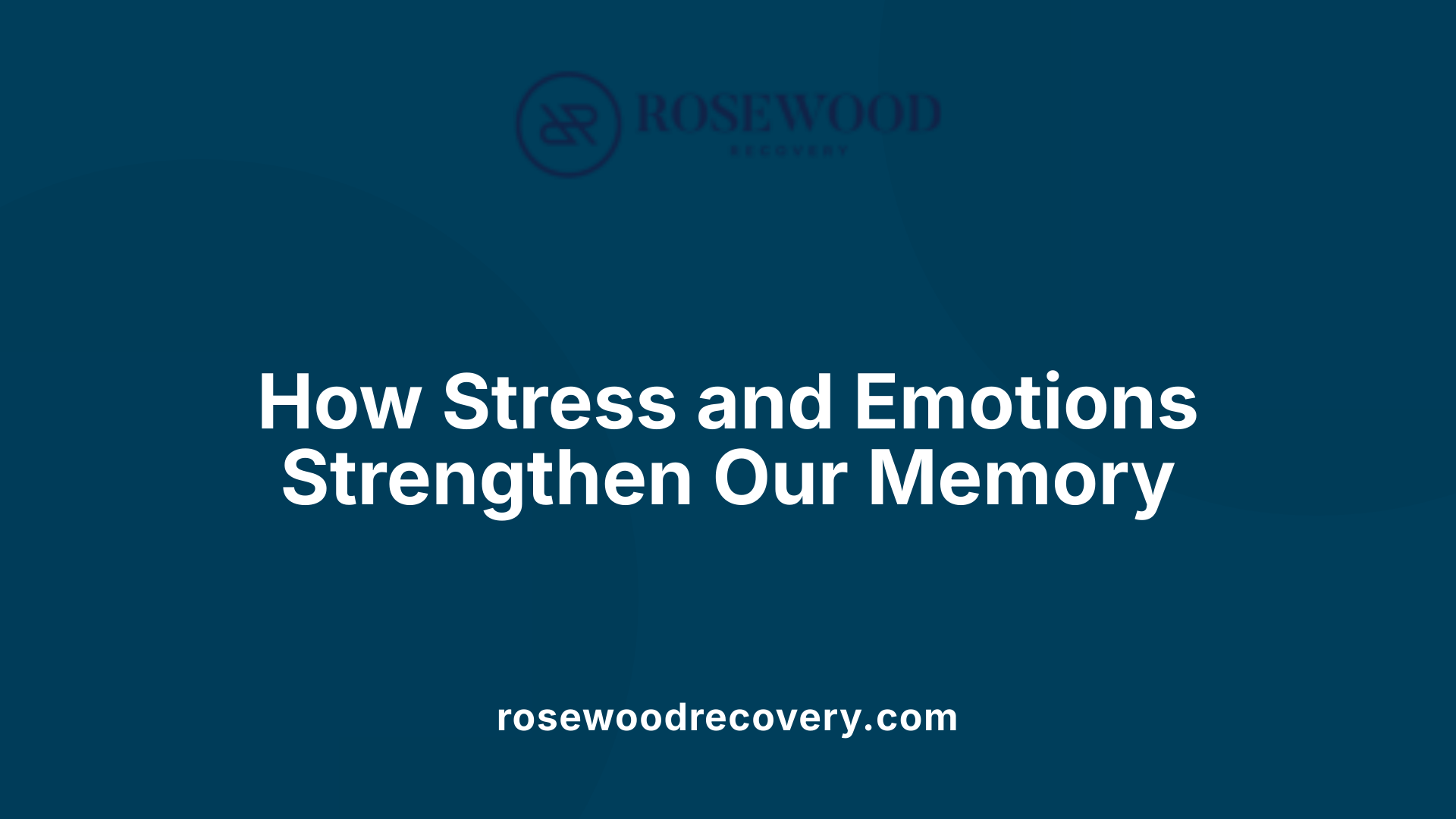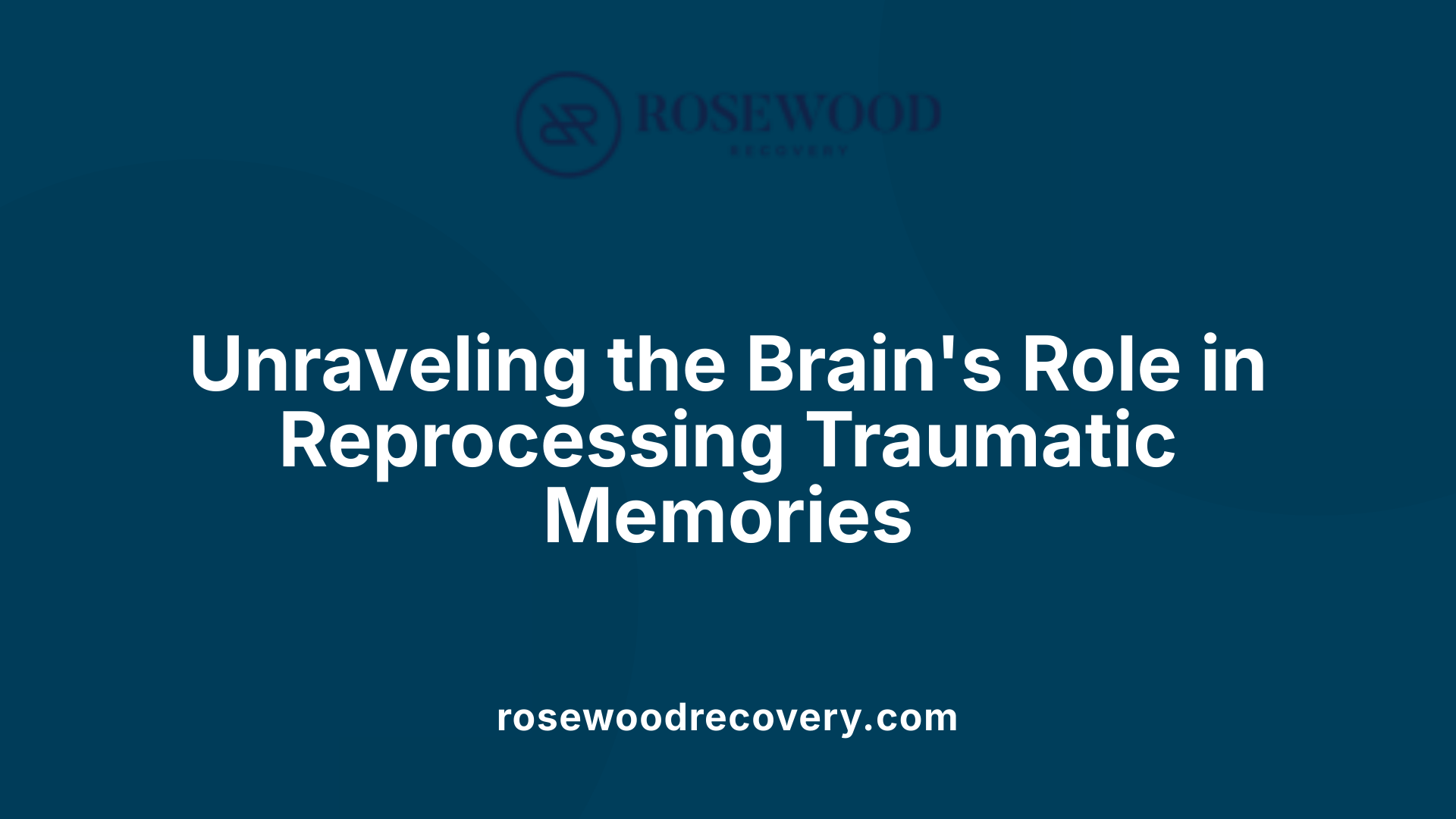How to reprocess emotionally charged memories
Transforming Traumatic Memories: Evidence-Based Approaches

Understanding and Managing Emotional Memories for Healing
Emotionally charged memories profoundly influence our mental health, shaping reactions, behaviors, and perceptions. Their vividness, persistence, and emotional impact often pose challenges in healing from trauma. This article explores the neurobiological foundations of emotional memory processing, examines effective therapeutic strategies like EMDR, and offers practical techniques to reprocess, regulate, and reframe these powerful memories, fostering resilience and emotional well-being.
Neurobiology of Emotional Memories and Why They Are More Memorable

What are emotionally charged memories and why are they more memorable?
Emotional memories are the recollections tied to significant experiences that evoke strong feelings, such as fear, joy, or grief. These memories often involve vivid sensory details—what we see, hear, or smell—that heighten their importance in our brain's storage system.
The reason these memories stick out more than neutral ones lies in the brain's emotional processing centers, especially the amygdala. When we encounter emotionally charged events, the amygdala becomes highly active, influencing other regions involved in memory formation like the hippocampus and prefrontal cortex.
This activation boosts the encoding process, effectively marking the memory as important. As a result, emotionally intense experiences are consolidated more deeply, making them easier to retrieve later. Additionally, these memories often serve a functional purpose—guiding future behavior or decision-making—and thus are prioritized for retention.
Beyond encoding, emotional arousal also enhances memory consolidation. During high emotional states, neurochemical changes—such as increased cortisol and adrenaline—modulate neural activity, supporting the transfer of memories from short-term to long-term storage.
Consequently, the brain's emphasis on emotionally salient information ensures that such memories are vivid, detailed, and enduring. This interplay between emotion and memory emphasizes why traumatic or profoundly joyful events are often remembered with haunting clarity or deep fondness, respectively.
Research into the neurobiological mechanisms behind emotional memory highlights the significant roles of the amygdala, hippocampus, and prefrontal cortex. The amygdala acts as an emotional gatekeeper, boosting the consolidation process by activating during emotionally intense events. The hippocampus helps contextualize these memories, integrating sensory details with emotional significance. Meanwhile, the prefrontal cortex regulates and modulates emotional responses, influencing how memories are processed and retrieved.
Understanding how emotional arousal enhances memory has important implications for therapies aimed at processing traumatic memories. Techniques like EMDR leverage this neural responsiveness to help reprocess distressing experiences, diminishing their emotional impact while retaining the factual details. This neurobiological insight underscores why emotional memories, although sometimes overwhelming, are inherently more persistent and potent in shaping our behaviors and perceptions.
Why Stress and Emotions Facilitate the Recall and Retention of Memories

Impact of emotional arousal on amygdala and hippocampus during memory formation
Emotional arousal during an event activates the amygdala, a brain structure essential for processing emotions like fear and pleasure. When the amygdala is engaged, it communicates with the hippocampus, which is responsible for creating and storing memories. This interaction enhances the encoding process, making details of emotionally charged experiences more vivid and durable.
The heightened activity of the amygdala during emotional events leads to stronger synaptic connections within the hippocampus, solidifying these memories into long-term storage. As a result, emotional memories tend to be more detailed and easier to recall compared to neutral ones.
Influence of stress hormones like cortisol on memory consolidation
Stress hormones, particularly cortisol, play a significant role in the strengthening of emotional memories. During stressful situations, cortisol is released into the bloodstream, reaching the brain and affecting neural plasticity. Moderate levels of cortisol can enhance memory consolidation by promoting synaptic strengthening in key areas like the amygdala and hippocampus.
However, prolonged or excessive stress and cortisol exposure can impair memory processes by damaging neurons involved in memory formation and retrieval. When balanced, cortisol acts as a neurochemical boost, ensuring that emotionally significant events are well-encoded and retained.
Role of sleep, especially REM stages, in reinforcing emotional memories
Sleep, especially REM (Rapid Eye Movement) sleep, is crucial in consolidating emotional memories. During REM sleep, the brain actively reprocesses and integrates newly encoded experiences, reinforcing emotional associations and reducing the emotional intensity over time.
Research indicates that REM sleep enhances the connectivity between the amygdala and hippocampus, further embedding emotional memories into long-term storage. Additionally, neural activity during REM helps weaken irrelevant details, allowing individuals to retain the core emotional significance without the extraneous sensory information.
| Factors | Effects on Emotional Memory | Neurobiological Basis |
|---|---|---|
| Emotional arousal | Amplifies memory encoding, making memories vivid and memorable | Activation of the amygdala, hippocampus |
| Stress hormones (cortisol) | Strengthens or impairs consolidation depending on level and duration | Modulates neural plasticity, synaptic strength |
| REM sleep | Reinforces emotional memory, reduces emotional charge | Enhanced amygdala-hippocampus connectivity |
Understanding how emotion and stress influence memory at neurobiological levels highlights their powerful role in personal experiences. These mechanisms explain why emotionally charged events tend to stand out in our minds, often shaping behaviors and perceptions long after the initial event.
Emotions and Their Influence on Memory Processing—Formation, Recall, and Reprocessing

How do emotions influence memory formation, recall, and reprocessing?
Emotions play a significant role in shaping how memories are created, retrieved, and modified. Neural pathways involving the amygdala, hippocampus, and prefrontal cortex are central to these processes.
During memory formation, emotional arousal activates the amygdala, a brain region crucial for processing fear and other strong emotions. This activation signals the hippocampus to encode and store memories more vividly, especially those tied to significant or emotionally charged events. As a result, emotionally intense experiences tend to produce memories that are more vivid, detailed, and durable.
When recalling memories, the current emotional state can bias what is retrieved through mood congruence—meaning that feelings like happiness or sadness can influence which memories surface. For instance, feeling anxious may make related past experiences more accessible, reinforcing certain emotional patterns.
Emotional arousal also affects reprocessing of memories. For example, therapies like EMDR utilize bilateral stimulation to help the brain re-evaluate traumatic memories, reducing their emotional impact. This reprocessing involves neural circuits between the amygdala, hippocampus, and prefrontal cortex, where the latter exerts top-down control to regulate emotional responses.
Impact of emotional states is not always beneficial. While high emotional arousal can enhance memory encoding, chronic stress may impair hippocampal functioning, leading to difficulties in accurate recall or the formation of fragmented memories. Conversely, effective emotional regulation strategies, such as mindfulness or cognitive reappraisal, can help mitigate distortions, promote healthier memory processing, and reduce maladaptive biases.
Therefore, emotions serve an adaptive purpose by prioritizing certain memories, but they can also create distortions that influence behavior and decision-making over time. Understanding these neural mechanisms offers important insights into therapies targeting emotional memories, such as EMDR, cognitive-behavioral approaches, and stress management techniques.
Neurobiological and Molecular Bases of Reprocessing Traumatic Memories

How do interactions among the amygdala, hippocampus, and prefrontal cortex facilitate memory reprocessing?
Reprocessing emotionally charged memories is a complex operation involving multiple brain regions working in concert. The amygdala, known for its role in processing emotions like fear and anxiety, enhances the encoding and consolidation of emotional memories. It communicates with the hippocampus, which is primarily responsible for contextualizing and storing new memories, to create detailed and vivid emotional recollections.
The prefrontal cortex (PFC), particularly the dorsolateral PFC, plays a pivotal role in regulating emotional responses and exerting top-down control over the amygdala and hippocampus. During memory reprocessing, the PFC modulates activity in these regions to diminish emotional reactivity and facilitate the integration of new, less distressing information. This interaction supports strategies like cognitive reappraisal and active suppression, which are used in therapies such as EMDR to weaken the emotional charge of traumatic memories.
Research shows that effective communication among these regions enables the brain to re-evaluate or reconsolidate memories, turning a distressing recollection into a less emotional one. This neural crosstalk forms the foundation for therapeutic interventions aiming to alter the emotional impact associated with traumatic memories.
What molecular pathways are involved in reprocessing emotional memories?
The process of reprocessing emotional memories hinges on specific molecular pathways that promote neural plasticity and memory modification. Brain-derived neurotrophic factor (BDNF) is crucial in this context. BDNF enhances synaptic strength and survival by binding to its receptor, TrkB, which activates downstream signaling pathways necessary for neural plasticity.
Cyclic AMP response element-binding protein (CREB) is another key molecule. It acts as a transcription factor that regulates gene expression essential for long-term memory formation and consolidation. Activation of CREB during memory reactivation facilitates the synthesis of proteins needed to stabilize new associations or weaken existing ones.
Stress hormones, such as cortisol and noradrenaline, further influence these pathways. Elevated glucocorticoid levels during traumatic events amplify amygdala activity, reinforcing the emotional memory trace. Conversely, controlled modulation of stress hormones during therapy can promote memory reconsolidation in a way that reduces emotional distress.
How does memory reconsolidation serve as an opportunity for memory modification?
Memory reconsolidation is a critical process where reactivated memories become plastic and susceptible to change. When a traumatic memory is recalled, it temporarily enters a labile state, allowing interventions to alter its emotional tone or factual content. This window of plasticity can be exploited through pharmacological means, such as glucocorticoid receptor antagonists, or through behavioral techniques like cognitive reappraisal.
Therapies utilizing reconsolidation aim to weaken the emotional intensity associated with traumatic memories, making them less distressing or even neutral. By intervening during the reconsolidation window, therapists can update negative memories with more accurate, positive, or neutral information, thereby diminishing symptoms of PTSD, anxiety, and depression.
Overall, understanding the neurobiological and molecular mechanisms underlying this process offers promising avenues for developing more targeted and effective treatments for trauma-related conditions.
Therapeutic Strategies for Managing and Reprocessing Traumatic Memories

Overview of EMDR, its phases, and neural mechanisms
Eye Movement Desensitization and Reprocessing (EMDR) is a structured psychotherapy developed in the late 1980s by Francine Shapiro. It utilizes bilateral stimulation, such as guided eye movements, sounds, or taps, to help individuals reprocess stressful or traumatic memories. EMDR therapy involves eight phases: history-taking, preparation, assessment, desensitization, installation, body scan, closure, and reevaluation. During sessions, clients focus on specific emotionally charged memories while engaging in bilateral stimulation, which activates neural pathways crucial for emotional regulation and memory integration.
Research indicates that EMDR influences brain regions associated with emotional memories, including the amygdala, hippocampus, and prefrontal cortex. The therapy promotes communication between the brain hemispheres, aiding in reducing emotional intensity and vividness of disturbing images. This process helps turn traumatic memories from 'stuck' experiences into integrated, less distressing memories.
Effectiveness of EMDR supported by research and health organizations
EMDR's success in treating trauma-related conditions is well-documented. Over 30 randomized controlled trials have affirmed its efficacy, especially for post-traumatic stress disorder (PTSD). Some studies report significant symptom reduction in as few as three sessions. Major health organizations, including the World Health Organization (WHO), the International Society for Traumatic Stress Studies (ISTSS), and the U.S. Veterans Affairs Department, endorse EMDR as an evidence-based treatment.
Research shows that EMDR can diminish the emotional charge of traumatic memories, improve cognitive flexibility, and lessen trauma symptoms such as flashbacks, nightmares, and hypervigilance. Its validation by reputable agencies underscores its role as a primary intervention in trauma therapy.
Additional therapies: exposure therapy, cognitive behavioral therapy
Beyond EMDR, other approaches effectively manage traumatic memories. Exposure therapy involves systematically confronting the feared memories or stimuli in a controlled way to reduce their distressing impact.
Cognitive Behavioral Therapy (CBT) helps individuals reframe negative beliefs and automatic thoughts related to trauma. Techniques like cognitive restructuring and gradual exposure are employed to weaken the association between trauma and distress.
Both therapies aim to process and diminish the power of traumatic memories but differ in approach. EMDR emphasizes bilateral stimulation and rapid reprocessing, whereas exposure and CBT often involve more conscious and structured cognitive engagement.
Non-therapeutic strategies like journaling, mindfulness, emotion regulation
In addition to therapy, various self-help tools support healing and managing emotional memories. Journaling about traumatic or intense experiences allows for objective reflection, which can reorganize memories and lessen their emotional impact.
Mindfulness practices, such as meditation and deep-breathing exercises, help regulate emotions and calm the nervous system, making it easier to withstand distressing memories.
Emotion regulation strategies like cognitive reappraisal and thought substitution enable individuals to reinterpret or redirect their responses to triggers. Developing these skills can buffer against overwhelming feelings and foster resilience.
Engaging in physical activity, maintaining routines, and building social connections further contribute to recovery. While these methods do not replace formal therapy, they serve as valuable adjuncts to promote emotional well-being.
| Therapy Type | Focus | Typical Duration | Notes |
|---|---|---|---|
| EMDR | Reprocessing traumatic memories | 3-8 sessions | Evidence-based, bilateral stimulation |
| Exposure Therapy | Systematic confrontation | Variable | Effective for phobias and PTSD |
| CBT | Reframing thoughts | Several weeks | Focuses on belief change and behavior |
These diverse strategies, used alone or combined, support individuals in managing and healing from emotionally charged memories, paving the way toward emotional freedom and resilience.
Pathways to Emotional Healing and Resilience
Understanding the neurobiological underpinnings of emotional memories and leveraging therapeutic tools like EMDR can significantly aid in processing and reprocessing traumatic experiences. Recognizing the powerful influence of emotions on memory formation and recall underscores the importance of employing targeted strategies—such as mindfulness, cognitive reappraisal, and active rehabilitation—to foster emotional regulation and resilience. As research continues to unveil the intricate workings of emotional memory pathways, effective interventions will evolve, empowering individuals to heal from trauma, diminish distress, and regain a sense of control and well-being.
References
- How EMDR Therapy Helps You Reprocess Painful Memories ...
- Ask a Therapist: How Do I Deal With Bad Memories? - Verywell Mind
- Emotions Can Affect Your Memory — Here's Why and How to Handle It
- How Ketamine Helps Reprocess Traumatic Memories in PTSD
- How EMDR helps to reprocess traumatic memories at warp speed
- Memory Control: A Fundamental Mechanism of Emotion Regulation
- EMDR: Eye Movement Desensitization and Reprocessing - WebMD
More Articles
Recovery Begins Here
Click below to get in touch and schedule a consult call with our team to begin your journey towards happiness and freedom.
Rosewood Recovery does not discrimate against any person because of the race, color, religious creed, ancestry, age, sex, sexual orientation, gender identity, national origin, handicap or disability or the use of a guide or support animal because of the blindness, deafness or physical handicap.




.jpeg)
